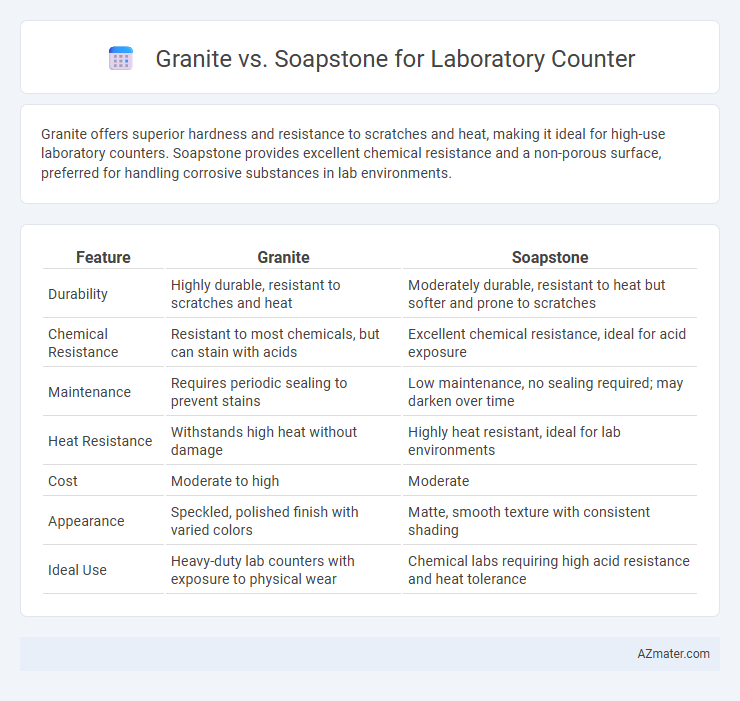Granite offers superior hardness and resistance to scratches and heat, making it ideal for high-use laboratory counters. Soapstone provides excellent chemical resistance and a non-porous surface, preferred for handling corrosive substances in lab environments.
Table of Comparison
| Feature | Granite | Soapstone |
|---|---|---|
| Durability | Highly durable, resistant to scratches and heat | Moderately durable, resistant to heat but softer and prone to scratches |
| Chemical Resistance | Resistant to most chemicals, but can stain with acids | Excellent chemical resistance, ideal for acid exposure |
| Maintenance | Requires periodic sealing to prevent stains | Low maintenance, no sealing required; may darken over time |
| Heat Resistance | Withstands high heat without damage | Highly heat resistant, ideal for lab environments |
| Cost | Moderate to high | Moderate |
| Appearance | Speckled, polished finish with varied colors | Matte, smooth texture with consistent shading |
| Ideal Use | Heavy-duty lab counters with exposure to physical wear | Chemical labs requiring high acid resistance and heat tolerance |
Introduction to Laboratory Countertop Materials
Granite and soapstone are popular laboratory countertop materials known for their durability and chemical resistance. Granite offers high hardness and heat resistance, making it suitable for heavy-duty lab use, while soapstone provides excellent resistance to acids and stains due to its non-porous nature. Both materials require proper sealing and maintenance to ensure longevity and maintain surface integrity in demanding laboratory environments.
Overview of Granite and Soapstone
Granite is a natural igneous rock known for its exceptional hardness, durability, and resistance to heat and scratches, making it a popular choice for laboratory counters where chemical resistance and longevity are crucial. Soapstone, composed primarily of talc, offers a softer, more non-porous surface with excellent chemical and heat resistance, valued for its ability to withstand acids and alkalis commonly used in labs. Both materials provide unique benefits, with granite excelling in toughness and soapstone favored for its non-reactive and low-maintenance properties.
Physical Properties Comparison
Granite exhibits superior hardness with a Mohs rating of 6-7, making it highly resistant to scratches and abrasions, while soapstone rates around 2.5-4, offering softer yet more renewable surface qualities due to its ability to be sanded down. Granite's high density and low porosity contribute to excellent heat resistance and chemical durability, essential for laboratory environments, whereas soapstone's composition includes talc and magnesium silicate, granting it exceptional thermal shock resistance but moderate susceptibility to stains. Both materials provide reliable stability, but granite typically demands less maintenance over time compared to soapstone, which requires periodic oiling to maintain its protective patina.
Chemical Resistance: Granite vs Soapstone
Soapstone offers superior chemical resistance compared to granite, making it highly suitable for laboratory counters exposed to acids and solvents. Granite, while durable and heat-resistant, can be more susceptible to etching and staining from acidic chemicals commonly used in lab settings. Choosing soapstone ensures better longevity and reduced maintenance costs due to its non-porous and inert surface properties.
Durability and Longevity
Granite offers exceptional durability and resistance to scratches, heat, and chemicals, making it highly suitable for laboratory countertops where heavy use and exposure to harsh substances are common. Soapstone, while softer than granite, exhibits excellent chemical resistance and does not react with acids or alkalis, ensuring long-term performance in environments involving chemical handling. Both materials provide long-lasting solutions, but granite's superior hardness results in greater longevity under heavy physical stress typical in laboratory settings.
Maintenance and Cleaning Requirements
Granite laboratory counters require periodic sealing to maintain stain resistance and prevent chemical damage, while soapstone offers a naturally non-porous surface that resists stains and acids without sealing. Cleaning granite surfaces demands pH-neutral, non-abrasive cleaners to avoid etching, whereas soapstone can be easily cleaned with mild soap and water, and minor scratches can be sanded out. Soapstone's low maintenance and superior chemical resistance often make it a preferred choice in laboratories with heavy acid use or frequent spills.
Cost Analysis and Budget Considerations
Granite countertops typically range from $50 to $100 per square foot, offering durability that justifies the investment for long-term laboratory use, whereas soapstone costs between $70 and $120 per square foot but provides superior chemical resistance and low maintenance. Budget considerations must include installation expenses, with granite generally less expensive to install due to wider availability and standardized fabrication processes compared to soapstone. Evaluating long-term costs, soapstone may reduce replacement and repair expenses due to its non-porous nature, while granite offers a more cost-effective upfront price suitable for laboratories with tighter budgets.
Aesthetics and Design Flexibility
Granite offers a wide variety of colors and intricate natural patterns, providing high aesthetic appeal and the ability to complement diverse laboratory designs. Soapstone features a smooth, matte finish with subtle veining, ideal for creating a sleek, minimalist look and offering consistent design flexibility. Both materials allow customization, but granite's vibrant palette and pattern diversity make it a preferred choice for visually dynamic lab environments.
Environmental Impact and Sustainability
Granite countertops offer durability and low maintenance but require energy-intensive quarrying and often involve chemical sealants, impacting the environment. Soapstone is more environmentally friendly due to its natural resistance to chemicals and heat, requiring less processing and fewer sealants, which reduces ecological footprint. Choosing soapstone supports sustainability by minimizing resource extraction and chemical use, making it ideal for eco-conscious laboratory designs.
Choosing the Right Material for Your Laboratory
Granite offers exceptional durability and resistance to scratches and heat, making it ideal for high-impact laboratory environments requiring long-term use. Soapstone provides excellent chemical resistance and is non-porous, which helps prevent contamination and makes it easier to maintain in labs handling corrosive substances. Selecting the right material depends on the specific laboratory application, with granite preferred for mechanical strength and soapstone favored for chemical stability and ease of cleaning.

Infographic: Granite vs Soapstone for Laboratory Counter
 azmater.com
azmater.com